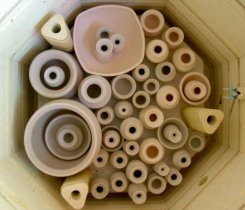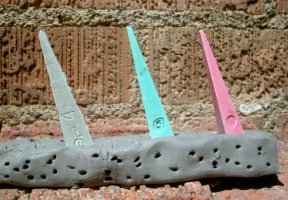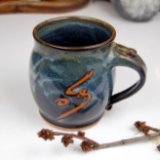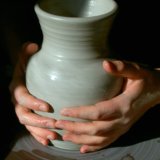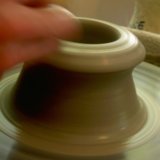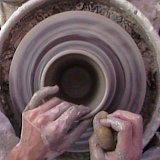|
Firing PotteryFiring pottery is both exciting and challenging. Perfect your
clay pot projects
through firing. Follow the process here from throwing
ceramic greenware pots to
painting clay pots with glaze.
Lifecycle of a PotWhen the life of a clay pot begins, it's just a ball of clay in your hands. With a little practice, elbow grease, and mud, it becomes a pot. Until the pot is fired, it is called
ceramic greenware.
Electric ceramics kiln
being loaded with ceramic greenware.
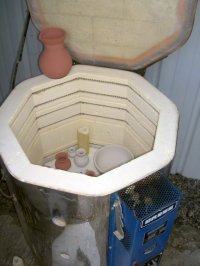
At this point the clay particles fuse together or "vitrify", and the pot is "mature". Mature clay is highly water resistant and durable. Note: Low fire pottery is less water resistant and durable than high fire pottery due to the additives that are required to help the clay to fuse at such low temperatures. In this final firing the glaze also vitrifies and fuses to the clay. The glaze further increases the water resistance and durability of your clay pot project. When this firing is finished your pot is complete!
Learn more about how to fire an electric ceramic kiln.
Right: Electric ceramic kiln being loaded with glazed pottery.
Kiln TypesThere are three major kiln types. Click on one of the links to learn more about each type.
Alternative Firing MethodsThere are a number of alternative firing methods as well including: saggar, barrel, pit and Raku firing. Many of these firing methods are not only the simplest, but are also the oldest methods of firing. Pit firing consists of burying the pottery and then creating a fire on top of the pots. Raku firing involves taking red hot pottery out of a gas kiln and placing into combustible material. This causes carbon to adhere to the glaze surface creating really fun glaze effects. FiringFiring pottery- is the process of controlling the heat rise in the kiln to produce the desired results. This accomplishes two things for the pots. First, it heats the pottery just to the point of maturity, bringing out it's highest quality and function. Second, it allows the potter to manipulate the fuels to create special glaze and surface effects. When firing pottery, there are several ways to determine when the pottery has reached the maturation point. The most common and reliable method is with Pyrometric cones are specially formulated cones of clay material designed to melt after they have experienced a certain amount of "heat work". Heat work- is a combination of temperature and time. Therefore, a cone fired over a longer time can melt at a lower temperature than a cone fired over a shorter time. This gives the potter a very accurate gauge of how the firing is going. Many kilns also contain pyrometers which measure the actual temperature in the kiln. This provides a rough estimate of how the firing is progressing. Tip: When firing pottery, always follow the kiln manufacturers safety recommendations. Use proper eye protection when looking into the kiln as the light can be damaging to the eye.
If I could recommend only one book about firing an electric kiln it would be Electric Kiln Ceramics: A Guide to Clays and Glazes It is one of those beautiful, valuable resources the pages of which have become speckled with glaze, creased, marked, and muddied from loving use. Almost all of what I understand about firing started from this book. Some people may find the price prohibitive, but the information in the book is well presented and worth every penny. I have looked for an acceptable alternative with no luck. If anyone is aware of a better book for a better price, please let me know.
Thanks for reading about the various methods of firing pottery, and Happy Potting.
|
Learn Right
The First Time
Pottery on the Wheel for Beginners
is a complete beginners guide
to learning pottery.
It will
take you from
never having touched clay
to creating finished pottery
you can use every day.
Also read it on Kindle
Featured Pages
Choose Your Wheel
Thank you so much for
visiting my website!
Discover How I Made It!
Happy Potting!
- Steve





